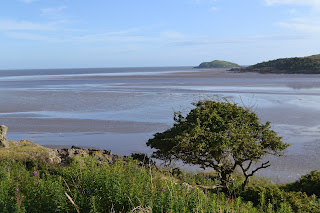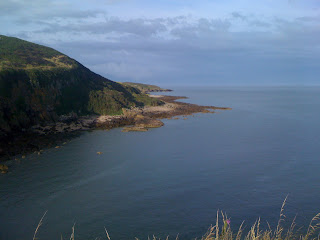To me, what makes the Urr Estuary so pretty and distinctive is not only the backdrop of hills (the highest in the area being Screel) but also the two small islands just sitting off shore.
Hestan, the larger of the two has a lighthouse and is the furthest from Rockcliffe and Kippford. Rough Island is the closest to the two villages and is an 8 hectare bird sanctuary; part of the 120 acres owned and managed around Rockcliffe and Kippford by the National Trust for Scotland. The NTS owned areas around Rockcliffe can been seen marked in lilac on this OS map. They are chiefly along the coast to the North West and South East of the village, including Rough Island Bird Sanctuary and described by the NTS as:
" A network of small paths, running through a mosaic of woodland, meadow and heather-topped granite outcrops, offer walkers fantastic views out to Rough Island and the Solway."
More information can be found here: NTS Rockcliffe
" A network of small paths, running through a mosaic of woodland, meadow and heather-topped granite outcrops, offer walkers fantastic views out to Rough Island and the Solway."
More information can be found here: NTS Rockcliffe
 |
| Looking towards Rough Island and Castle Point from Kippford |
The National Trust for Scotland protect this acreage and care for the meadows. Their management of these i.e. cutting, raking and grazing. (You will see Highland Cattle grazing the meadow near the Mote of Mark in the Winter months ) over a period of time has resulted in a rich and diverse mix of wildflowers and grasses. In turn these meadows are the home to many mammals, birds and invertabrates.
These photographs were taken on an evening walk out to Rough Island in early August. We always look forward to the end of the bird breeding season when it's OK to walk out there at low tide. (Always check the tides before setting off as they come in very swiftly)
(PLEASE NOTE:To prevent disturbance to courting,nesting and breeding birds please do not visit the island during May, June and July.)
These photographs were taken on an evening walk out to Rough Island in early August. We always look forward to the end of the bird breeding season when it's OK to walk out there at low tide. (Always check the tides before setting off as they come in very swiftly)
(PLEASE NOTE:To prevent disturbance to courting,nesting and breeding birds please do not visit the island during May, June and July.)
 |
| Shell Beach at Kippford |
Although you can wade through the mud direct from Rockcliffe beach, there is a causeway across to the island which runs from the shell beach along from Rough Firth, Kippford. You can see the causeway in the photo below. I have been accused in the past of only photographing the area with the tide in. I think its just as beautiful with the tide out as it takes on a different beauty. It's this dynamic vista that makes the area so appealing.
 |
| Causeway to Rough Island |
A big feature of the Estuary is the intertidal mud flats created by sediment washed in from the sea. This mud is inhabited by a large number of invertabrates which adapt to live in this environment. Its these worms crabs and shellfish that provide a meal for ducks and waders.
 |
| Looking from Rough Island towards Rockcliffe |
Once on the island, thanks to the diligence of the NTS, it is pleasant to stroll up the spine of the island to the stone cairn, a jumbled pile of rocks assembled, no doubt, by many generations. This is a lovely spot to sit and look out to Hestan Island, Castle Point and across to the Cumbrian Coast with the peaks of the Lake District behind. Hidden in the cairn is a (pre-Geocaching) time capsule, a battered biscuit tin full of pens, notes, tickets, business cards etc., that you can add your own messages to or leave small mementoes in. The children love it so if you discover it please make sure it is left intact and sealed for others to discover and enjoy.
 |
| From the cairn, Rough Island: the Urr Estuary towards Kippford with the Muckle to the Right |
 |
| From the cairn, Rough Island; looking North West |
 |
| From the cairn, Rough Island; Hestan Island |
The National Trust for Scotland is a charitable organisation with its aim to promote, conserve and manage Scotlands natural and cultural heritage. You can find out more and can join at:
All photographs taken with my Nikon. Copyright L. Birdsall
Source: Mudflats to Meadows Rockcliffe Dumfries and Galloway produced by National Trust for Scotland













